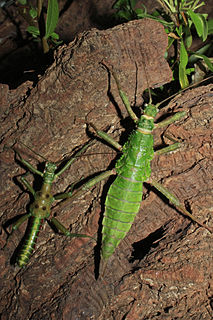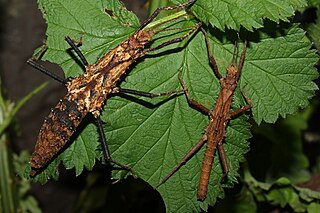
The Heteropterygidae is a family of stick insects belonging to the suborder Euphasmatodea. Species can be found in Australasia, East and Southeast Asia. More than 130 valid species are descriebed.

Pylaemenes is a genus of stick insects in the family Heteropterygidae and subfamily Dataminae. It combines small to medium-sized, often brightly colored Phasmatodea species. Their representatives are found in large parts of Southeast Asia.

The Obriminae are the most species-rich subfamily of the Phasmatodea family Heteropterygidae native to Southeast Asia. It is divided into two tribe.

Hoploclonia is the only genus of the tribe Hoplocloniini and brings together relatively small and darkly colored Phasmatodea species.

The Obrimini are the most species-rich tribe of the Phasmatodea family of the Heteropterygidae native to Southeast Asia.

Mearnsiana is a monotypic genus of stick insects, containing Mearnsiana bullosa as the so far only described representative.

The genus Tisamenus native to the Philippines combines small to medium-sized species of stick insects.

Aretaon is a genus of stick insects native to Borneo and the Philippine island Palawan.

Trachyaretaon is a genus of stick insects native to the Philippines.

Brasidas is a genus that is native to the Philippines and is named after the Spartan general Brasidas

Eubulides is a stick insect genus native to the Philippines.

Orestes guangxiensis is a representative of the genus Orestes.

Orestes japonicus, a stick insect, is a representative of the genus Orestes.

Orestes shirakii is a species of stick insects native to Taiwan.

Dares murudensis is a relatively small species of stick insects. Like most other members of the genus Dares, the species is native to Borneo.

Dares philippinensis is a species of stick insects. This species is not native to Borneo like most other members of the genus Dares, but to the Philippine island Palawan.

Dares ulula is a species of stick insects. Like most other members of the genus Dares, the species is native to Borneo, more precisely in the northwest of the island. The males are extremely prickly even for the representatives of the genus Orestes. Females are colored with a relatively high contrast.

Trachyaretaon carmelae is a species of stick insects. Even if there was no formal synonymisation, Trachyaretaon brueckneri is generally used as its synonym.

Tisamenus serratorius is a stick insect species that occurs on the Philippine island Luzon.

Tisamenus deplanatus is a stick insect species native to the Philippine islands Luzon and Mindanao occurs.



















